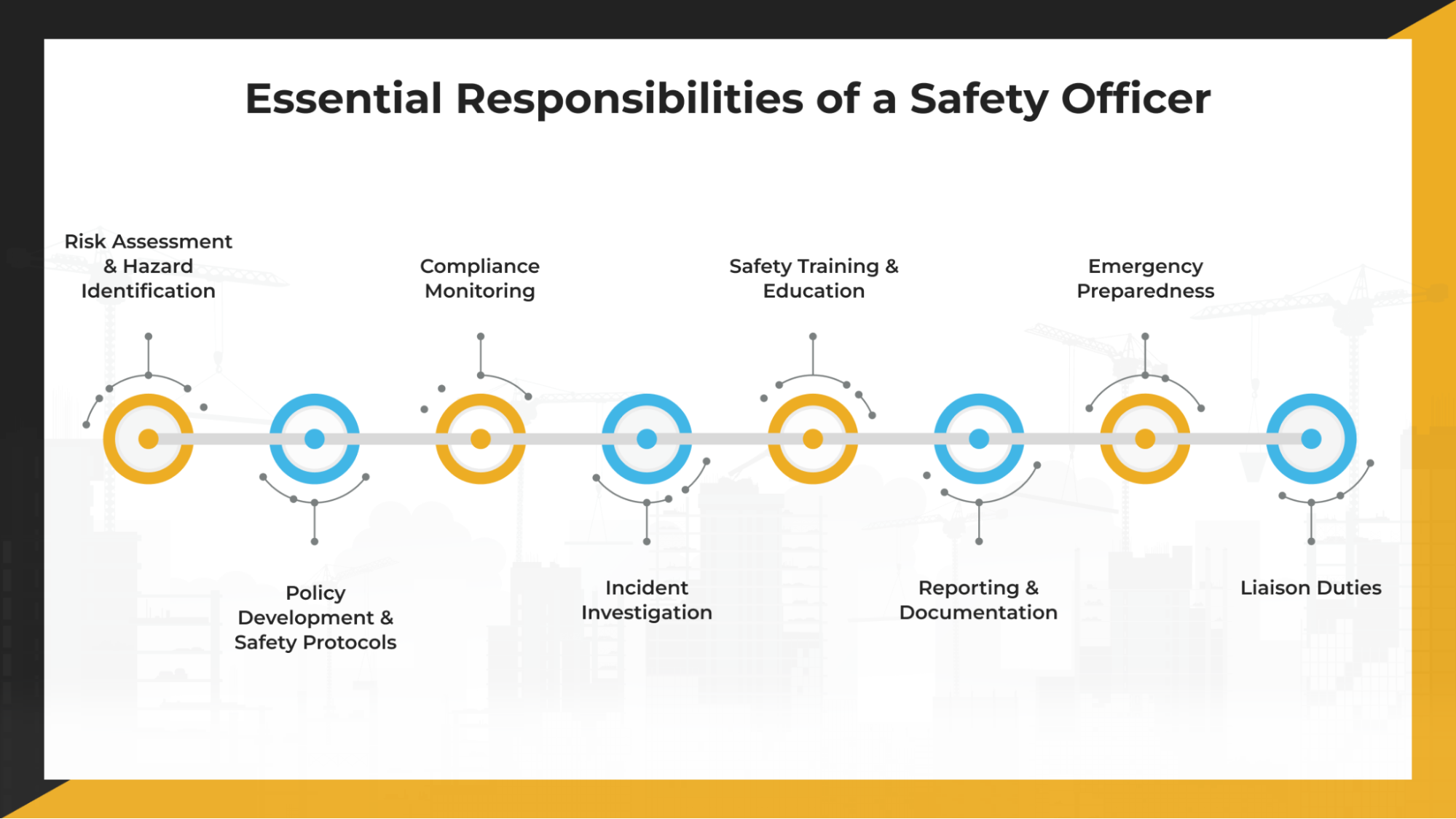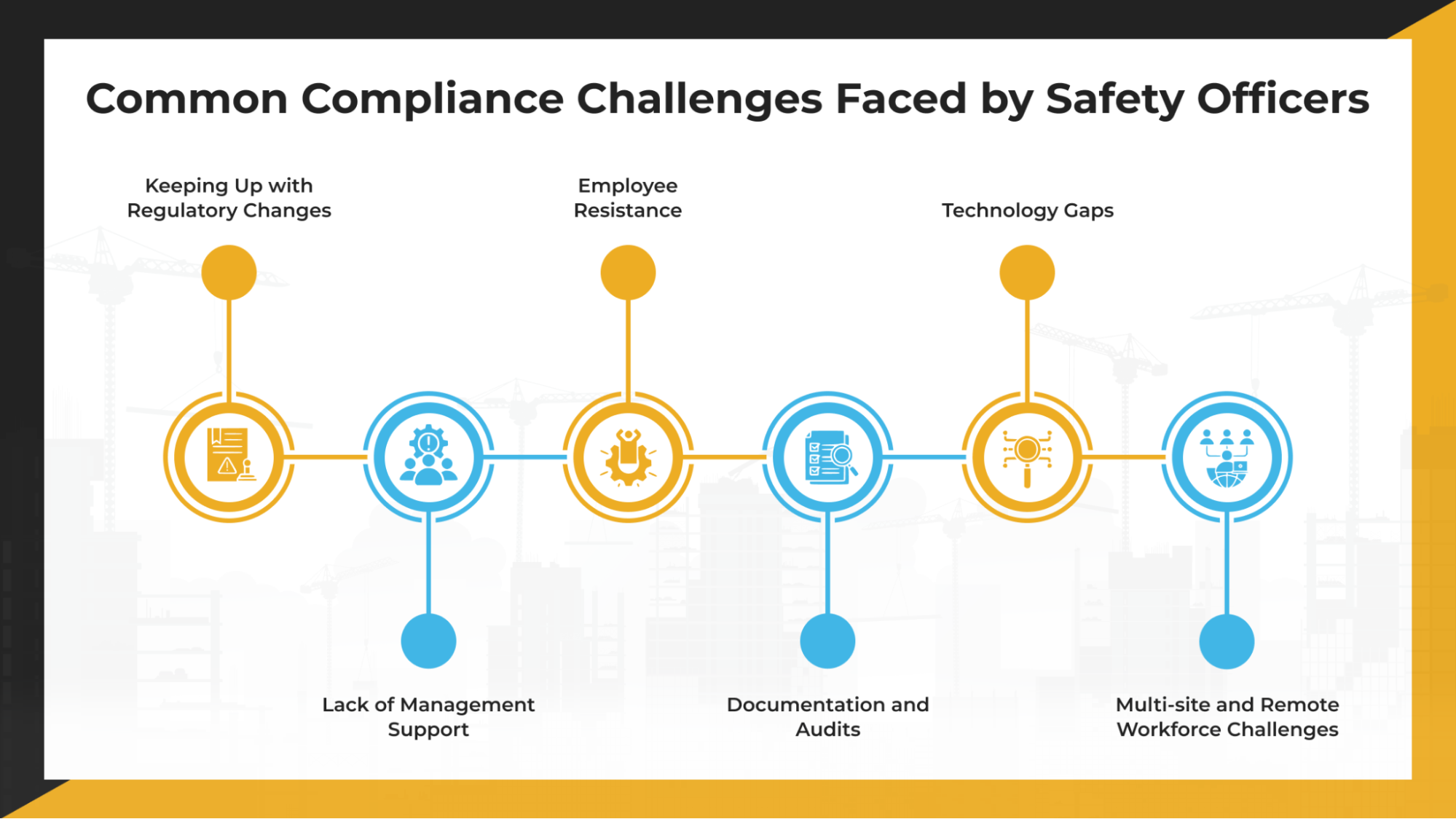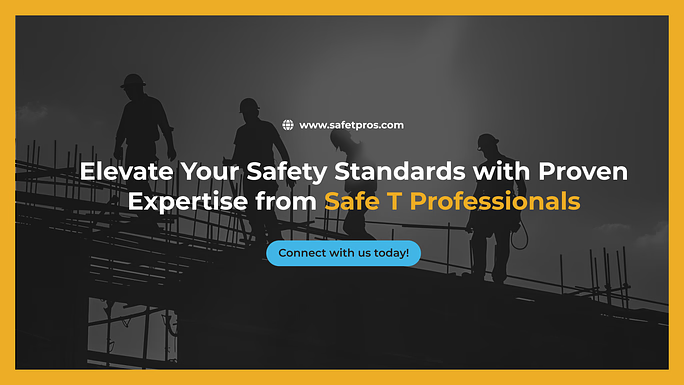What would you say if someone asked who keeps your team safe?
The answer might surprise you, because it’s not just one person. It’s your entire operation. However, one role makes safety happen every day: behind the scenes, the Safety Officer.
Jobs run on tight deadlines, machinery operates nonstop, and teams work in high-pressure, high-risk environments. In all this, one person is actively spotting risks before they escalate, ensuring your team knows what to do in an emergency, and ensuring your business isn’t caught off guard during a surprise inspection.
And it’s not getting easier.
The modern workplace is shifting fast. The scope of safety management has expanded from stricter post-pandemic health expectations to the rise of automation and ESG reporting. Today’s Safety Officers aren’t just enforcing rules; they’re building safer systems, using digital tools to track risk, and helping companies like yours avoid costly disruptions.
This blog explains what makes a Safety Officer essential in today’s industrial and construction environments.
The Core Role of a Safety Officer
A Safety Officer is trained to manage your workplace’s health and safety standards. They hold a background in occupational health, industrial safety, or environmental safety, along with certifications like NEBOSH, OSHA, or ISO 45001 training.
If you run a construction site, factory, warehouse, or production facility, your Safety Officer is the one who keeps your teams safe and operations uninterrupted.
Industries Where Safety Officers Are Essential
Here’s how their role plays out in industries:
Construction
On a construction site, risks are everywhere, from working at heights to electrical setups. The safety officer will ensure scaffolds are stable, monitor the use of PPE (like helmets, gloves, and harnesses), and confirm that workers are trained in the equipment they use. They help you avoid injuries that can stall entire projects.
Manufacturing
In factories, you have fast-moving machines, chemicals, and high temperatures. A Safety Officer sets up lockout/tagout procedures, monitors air quality and noise levels, and manages evacuation plans in case of fire or leak. They make sure production doesn’t come at the cost of worker safety.
Oil & Gas
The oil and gas sector is at high risk due to flammable materials and remote site conditions. Safety Officers supervise safety drills, monitor gas leaks, and manage permit-to-work systems. They are crucial in preventing catastrophic accidents.
Warehousing & Logistics
Warehousing is another high-risk area with forklifts, stacked goods, and round-the-clock shifts. Safety officers conduct aisle and loading dock inspections, ensure safe lifting practices, and enforce traffic control for warehouse vehicles. This reduces injuries and keeps inventory moving safely.
Essential Responsibilities of a Safety Officer
A Safety Officer is central to daily safety checks and long-term planning. Below are the core responsibilities that define their role on-site and at a policy level.
1. Risk Assessment & Hazard Identification
One of the first tasks a Safety Officer takes on is identifying potential dangers at the workplace. This includes conducting routine inspections across job sites, reviewing equipment conditions, checking electrical wiring, and monitoring worker activities.
The goal is to spot anything that could lead to an accident, whether it’s a leaking valve, poor lighting, or cluttered walkways. Once identified, they assess the severity of each risk and take action to control or eliminate it before it causes harm.
2. Policy Development & Safety Protocols
Safety Officers write and update safety policies and procedures tailored to your work environment. This includes creating Standard Operating Procedures (SOPs), emergency evacuation plans, PPE usage guidelines, and machine handling rules.
These documents act as a blueprint for safe work behavior and must be revised regularly to reflect changes in regulations, equipment, or site conditions.
3. Compliance Monitoring
Every workplace must follow local and international safety laws. A Safety Officer ensures your organization complies with frameworks such as OSHA (Occupational Safety and Health Administration), ISO 45001, and national safety codes.
This involves verifying that safety signs are appropriately placed, exit routes are accessible, and safety equipment is available and functioning. The officer also helps prepare for external audits and ensures all standards are being met consistently.
4. Incident Investigation
If an accident or near miss occurs, the Safety Officer investigates it thoroughly. They gather witness statements, review CCTV footage, inspect the area, and analyze what went wrong.
Their job is to identify the root cause, not just what happened, but also why. Based on the findings, they implement corrective actions to prevent future incidents, including additional training, equipment changes, or stricter protocol enforcement.
5. Safety Training & Education
Training is an ongoing responsibility. Safety Officers regularly conduct induction programs for new employees and refresher sessions for existing staff.
These sessions cover using PPE, emergency response steps, hazard communication, and safe equipment handling. The officer also leads safety drills, such as fire evacuation or first-aid simulations, to ensure everyone knows how to react in real situations.
6. Reporting & Documentation
Accurate and up-to-date records are critical for compliance and internal review. Safety Officers maintain logs of daily inspections, safety meetings, incident reports, audit results, and training attendance.
These records serve as proof of due diligence and can be used to identify patterns or recurring problems over time. Good documentation also protects your business in case of legal scrutiny.
7. Emergency Preparedness
Preparedness goes beyond having fire extinguishers. A Safety Officer develops and tests comprehensive emergency response plans for various scenarios, including fires, chemical spills, electrical outages, and natural disasters.
They ensure all employees know the evacuation routes, assembly points, and roles during emergencies. They also coordinate first-aid training and ensure medical kits are easily accessible and regularly stocked.
8. Liaison Duties
A Safety Officer often acts as the link between different departments and external bodies. Internally, they work with HR to ensure safety policies align with company policies and with site managers to implement controls effectively.
Externally, they coordinate with regulatory authorities during inspections and audits and collaborate with vendors or safety consultants when specialized advice or services are needed.
The Must-Have Skills and Qualifications for Modern Safety Professionals
A safety officer needs a combination of technical knowledge, soft skills, and formal certifications to be effective in the role. These enable them to understand safety risks, communicate clearly, and act promptly.
Technical Skills
A strong working knowledge of safety regulations is a must. Safety Officers must understand and apply standards like OSHA (Occupational Safety and Health Administration), ANSI (American National Standards Institute), NFPA (National Fire Protection Association), and ISO 45001. These regulations guide everything from personal protective equipment (PPE) use to fire prevention, electrical safety, and hazard communication. Knowing these standards helps ensure your workplace meets legal requirements and avoids penalties or shutdowns.
Proficiency in EHS Software
Many organizations use EHS (Environmental Health and Safety) software to streamline safety management. A Safety Officer should be comfortable using tools to log incidents, schedule inspections, track corrective actions, and generate compliance reports. This helps maintain accurate records and allows safety efforts to be tracked in real time.
Communication and Interpersonal Skills
A Safety Officer must communicate clearly with site workers, supervisors, management, and external inspectors. Whether giving safety instructions, leading a training session, or reporting hazards, the ability to convey messages in a way everyone understands is essential.
Analytical Thinking and Problem-Solving
Analyzing a workplace for risks or investigating an incident requires careful thinking. Safety Officers must assess complex situations, identify the root cause of problems, and recommend practical solutions. This helps prevent future accidents and ensures the effectiveness of corrective actions.
Minor safety oversights can lead to serious consequences. That’s why attention to detail is crucial, whether checking if a guardrail is secure, reviewing a maintenance log, or inspecting fire extinguishers. Noticing minor issues early can prevent larger problems later.
Leadership and Team Management
A Safety Officer often leads safety committees or manages safety reps across different departments. They must motivate others to follow safety procedures, guide teams during drills, and enforce rules when necessary. Strong leadership ensures that safety protocols are respected and followed consistently.
Certifications and Education
NEBOSH (National Examination Board in Occupational Safety and Health)
This is one of the most widely recognized safety certifications worldwide. It covers risk assessment, hazard control, and legal compliance. NEBOSH is often a minimum requirement for many industrial and construction safety roles.
OSHA Certification
Offered by the U.S. Department of Labor, this certification helps professionals understand workplace hazards and health standards. It is essential for Safety Officers working in or with U.S.-based companies or contractors.
CSP (Certified Safety Professional)
This advanced certification, offered by the Board of Certified Safety Professionals (BCSP), demonstrates expertise in comprehensive safety management and is ideal for officers taking on leadership or consulting roles.
Bachelor’s Degree
Most Safety Officers hold a bachelor’s degree in Occupational Safety, Environmental Health, Industrial Hygiene, or a related field. This education provides the foundational knowledge to assess risks, understand regulations, and implement safety programs effectively.
These skills and qualifications enable a Safety Officer to do their job confidently and professionally, protecting workers, meeting compliance standards, and contributing to a safer work environment.
Common Compliance Challenges Faced by Safety Officers
Even with experience and training, Safety Officers face several practical challenges while maintaining safety and compliance across different types of workplaces. Here are a few of the challenges faced by safety officers:
Keeping Up with Regulatory Changes
Safety laws and standards change frequently. New versions of OSHA, NFPA, or local workplace safety rules are introduced to address modern risks or update existing practices. A Safety Officer must stay updated on these changes to avoid non-compliance.
However, this often requires regular training, monitoring government updates, and revising internal procedures, which can be time-consuming without dedicated support.
Lack of Management Support
Sometimes, safety measures are delayed or underfunded due to a lack of support from upper management.
Safety Officers may struggle to get approval for new policies, proper PPE, training sessions, or necessary equipment upgrades. Without adequate budgets or timely decisions, it becomes difficult to implement meaningful improvements or correct known hazards.
Employee Resistance
It can be challenging to get employees to follow safety protocols consistently. Some may ignore rules due to overconfidence, time pressure, or simply not understanding the risks involved.
Others may resist wearing PPE or bypass safety procedures to finish tasks faster. A Safety Officer must continuously educate, correct, and motivate employees to maintain safe behavior without causing friction.
Documentation and Audits
Accurate documentation is critical for compliance, especially during audits or incident reviews. However, maintaining complete and well-structured records is often a challenge.
Safety logs may be incomplete, inspection checklists may be misplaced, or reports may not follow standard formats. This can lead to issues during external audits or in the event of a regulatory investigation.
Technology Gaps
Many organizations still use manual or outdated systems to track safety performance. Paper-based checklists, spreadsheets, and email follow-ups can lead to errors and delays.
Without proper EHS software or digital tools, Safety Officers have difficulty collecting data, tracking corrective actions, or generating compliance reports efficiently. This can also impact how quickly they respond to emerging issues.
Multi-site and Remote Workforce Challenges
Enforcing uniform safety practices becomes more complex in companies with operations across multiple sites or in remote locations. Each site may have different supervisors, processes, or resource limitations.
Ensuring that every location follows the same safety standards, conducts regular training, and maintains updated records requires consistent communication, strong coordination, and frequent travel or remote monitoring, adding to the officer’s workload.
Beyond Checklists: How Safety Officers Are Using Data & Digital Tools to Drive Safety
As workplaces adopt new technologies, the role of the Safety Officer is also changing. Digital tools are now becoming a regular part of safety management. These tools improve how risks are monitored, data is tracked, and decisions are made. Below are the essential ways in which safety practices are becoming more tech-driven.
Integration with IoT and AI-Driven Safety Monitoring
Many companies now use Internet of Things (IoT) devices and AI systems to monitor real-time safety conditions. Sensors can be placed on machinery, helmets, or work zones to detect gas leaks, heat levels, motion, or dangerous vibrations.
These devices send data continuously to a central system. AI tools can then analyze this data to spot abnormal patterns and predict potential safety issues before they happen. For example, if a machine is vibrating more than usual, the system can alert the Safety Officer to check it before it breaks down or causes injury.
Mobile Apps for Hazard Reporting
Mobile apps are making it easier for employees to report hazards immediately. Instead of filling out forms or waiting to speak to a supervisor, workers can take a photo, write a short note, and submit it through an app.
This improves the speed at which Safety Officers receive information and allows them to act faster. These apps also help Safety Officers assign follow-up tasks, track resolution progress, and store reports for future audits.
Real-Time Analytics for Predictive Safety Management
Digital dashboards now allow Safety Officers to track key real-time safety indicators. These may include near-miss reports, inspection outcomes, incident frequency, or PPE usage. With this data, they can identify problem areas and take preventive action.
For example, if a particular department has a rise in minor incidents, extra training or a risk assessment can be scheduled immediately. This predictive method helps prevent serious accidents by addressing early warning signs.
ESG (Environmental, Social, Governance) Alignment and Reporting
Today, many businesses are expected to align their operations with Environmental, Social, and Governance (ESG) standards. Safety Officers contribute to the “Social” and “Governance” aspects by ensuring workplace safety, employee well-being, and regulatory compliance.
They are often involved in creating reports that show safety performance, training efforts, and improvement plans. Stakeholders, investors, or clients review these reports as part of corporate responsibility. In this way, the Safety Officer’s role extends beyond operations and becomes part of the company’s broader ESG strategy.
Elevate Your Safety Standards with Proven Expertise from Safe T Professionals
At Safe T Professionals, we are dedicated to elevating safety standards through our expert consulting and staffing services. By proactively addressing and preventing safety issues and equipping your workforce with the necessary knowledge and tools, we help create a safer work environment.
Partner with Safe T Professionals to enhance your company’s HSE protocols, ensure compliance with industry regulations, and mitigate workplace hazards. Whether you are looking to fill safety-specific roles or need expert consultation to reduce workplace hazards, we are here to help.
Connect with us today!





